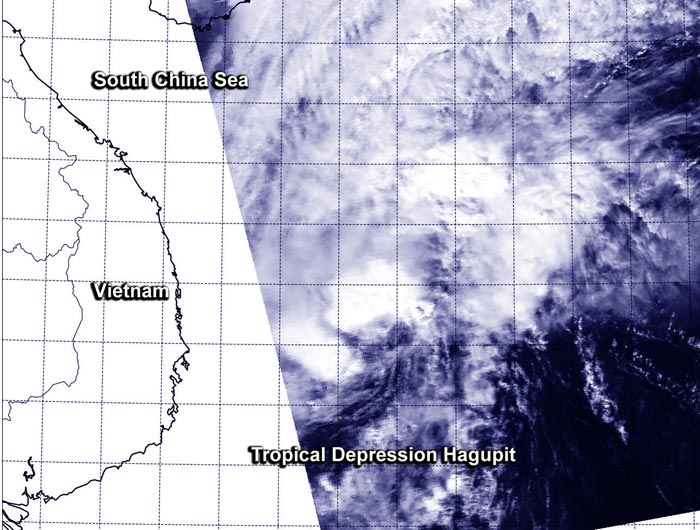NASA Sees Hagupit Weaken to a Depression Enroute to Vietnam

NASA's Aqua satellite passed over Hagupit on Dec. 11 at 05:20 UTC (12:20 a.m. EST) and saw thunderstorms had become fragmented around the circulation center. Image Credit: NASA/NRL
NASA's Aqua satellite passed over Hagupit on Dec. 11 at 05:20 UTC (12:20 a.m. EST) and the MODIS instrument captured a visible image of the storm.
The MODIS image showed that the thunderstorms had become fragmented around the circulation center.
On Dec. 11 at 1500 UTC (10 a.m. EST) Tropical Depression Hagupit's maximum sustained winds dropped to 30 knots (34 mph/55 kph).
It was centered near 12.8 north longitude and 110.9 east latitude, about 314 nautical miles (361 miles/581 km) east-northeast of Ho Chi Minh City, Vietnam. It was moving to the west at 8 knots (9.2 mph/14.8 kph).
The Vietnam National Centre for Hydro-meteorological forecasting has issued a tropical depression warning for southern Vietnam. For the latest forecasts and warnings, visit:
http://www.nchmf.gov.vn/Web/en-US/104/102/24189/Default.aspx
Hagupit is moving west-southwest toward southern Vietnam, where final landfall is expected around Dec. 12 at 0000 UTC. The system is forecast to dissipate quickly after landfall.
Rob Gutro
NASA's Goddard Space Flight Center
Media Contact
All latest news from the category: Earth Sciences
Earth Sciences (also referred to as Geosciences), which deals with basic issues surrounding our planet, plays a vital role in the area of energy and raw materials supply.
Earth Sciences comprises subjects such as geology, geography, geological informatics, paleontology, mineralogy, petrography, crystallography, geophysics, geodesy, glaciology, cartography, photogrammetry, meteorology and seismology, early-warning systems, earthquake research and polar research.
Newest articles

Trotting robots reveal emergence of animal gait transitions
A four-legged robot trained with machine learning by EPFL researchers has learned to avoid falls by spontaneously switching between walking, trotting, and pronking – a milestone for roboticists as well…

Innovation promises to prevent power pole-top fires
Engineers in Australia have found a new way to make power-pole insulators resistant to fire and electrical sparking, promising to prevent dangerous pole-top fires and reduce blackouts. Pole-top fires pose…

Possible alternative to antibiotics produced by bacteria
Antibacterial substance from staphylococci discovered with new mechanism of action against natural competitors. Many bacteria produce substances to gain an advantage over competitors in their highly competitive natural environment. Researchers…





















